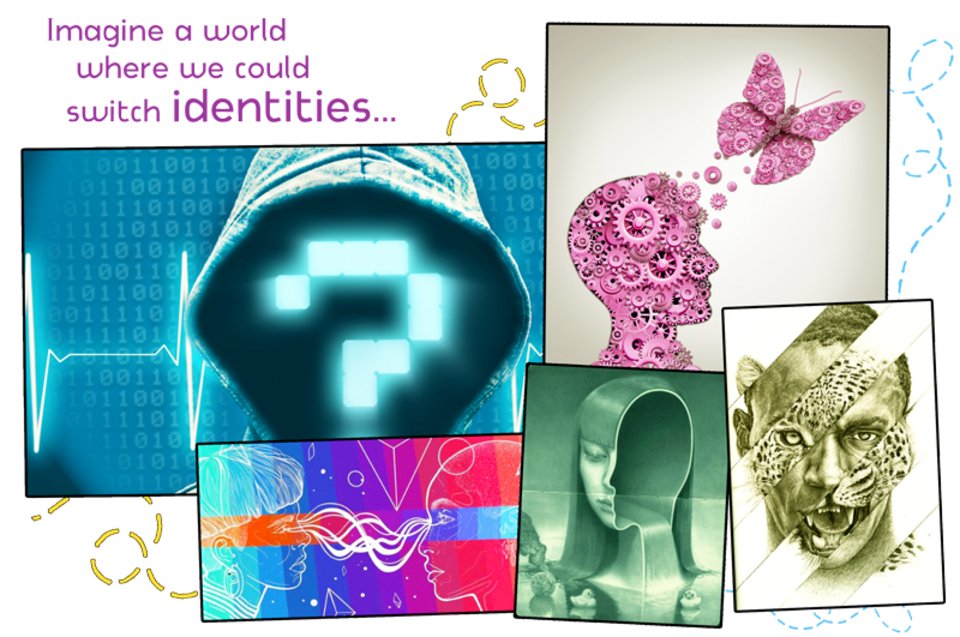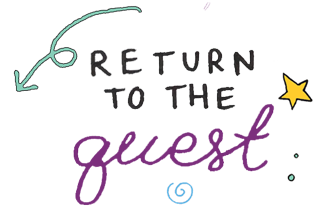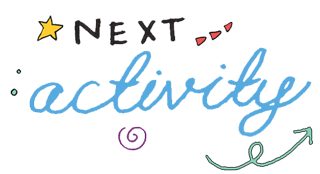
Switching identities
| Objective: To envision a completely different universe in order to reveal the hidden dimensions of the concept of identity! |
Duration: 30 to 90 minutes
Material:
- Sheets of paper and pens
- Coloured pencils and markers
Instructions:
Thought experiment: Imagine a world where... we could switch identities with others! What would this world look like? Would it be fantastic or horrible? How would this world be different from ours? How would life change? Would you want to live in this alternate world? Why or why not?
...
- Think about the effects. As you start brainstorming, you might start to wonder about what it really means to have an identity. If we could switch identities with someone else, would that mean we’d no longer be ourselves… or just part of us would change? Try imagining what this might be like by projecting your identity—who you are—into another person’s body or experience, almost like slipping on a new costume! What would be different? What would stay the same? Would it simply be you in another envelope? Or perhaps the envelope is part of who you are… in other words, maybe your identity is tied to your body and your experience of the world. Phew, this is one strange thought experiment! Now, let your mind toy with the idea that everyone can switch identities with each other. What kind of world would that create? Make a list of three positive and three negative points of switching identities, and add reasons to explain your impressions.
- Variation: Consider how this world might affect life in different contexts, such as: relationships, school, jobs, government, art, religion, the environment, etc.
- Create a character. To take your thinking one step further, think about how this alternative world might affect different people in society. Who might be really motivated to switch identities and why? On the flip side, who might be quite intent on staying themselves, and for what reasons? Now imagine an identity switch between one person from each of these two categories! What causes the switch and how do the characters first react? In as much detail as possible, describe their unique experience of suddenly having one another’s identity. How is their everyday life affected? What is lost and what is gained? Do they want their original identity back… or are there perks to being someone else? Imagine how this crazy switch feels in terms of their thoughts, emotions and motivations. It may help to write in the first-person to get into their deepest reactions! And what about the other people in their lives—how are they coping with the identity switch?
- Represent this world. Based on your reflections, imagine how you could represent your impressions of this alternative world—through a drawing, a collage, a diagram, a poem, or a dance. Your style can be realistic, abstract, comic, dramatic, etc. How could this world help us better understand—and even improve—our own?
...
Bonus: Many myths and folkloric tales tell stories of shapeshifting, that is, the magical ability to change into a physically different being. This transformation is often expressed as a way to wield power over others—for good but also for evil!—or to punish bad behaviour. For instance, in Greek mythology, Metis could proudly change into whatever she wanted… which annoyed her husband Zeus so much that he swallowed her after tricking her into becoming a fly! Playing with the idea of shapeshifting, think back to a time in your life when it may have been useful to have this magical ability to change into another life form. Maybe it was a tough situation that could have benefited from animal strength, or a goofy moment when you could have light-heartedly surprised a friend by becoming an insect! Once you have your scenario in mind, think through the shapeshifting transformation: what has to change about who you are so you can become the other physical being? And how would you think, feel and behave differently as a shapeshifter? Imagine how your chosen situation would have played out if you had shapeshifted instead of staying yourself. Then, ask yourself: Are we limited by our identity? Can we change who we are? Why or why not? |

| Tricks for tots: Finding it tricky to imagine switching identities? Worry not—it’s such a strange idea! To help you get in the groove, why not try imitating other people’s identities instead? Think of a few people who you feel like you know very well. Then, on the count of three, pretend you have turned into them by doing an impression of how they talk, walk, think, act and carry themselves. Spend a few minutes as this new character, trying to do ordinary things but as if you were them: how do they drink water, sit on the couch, talk about their day? For an even bigger challenge, try imagining how they might think and feel, based on what you know about them. When you’re done, compare your imitation of the person to how you think you are. Are your identities different? How would you change if you became them for real? |
| Tips for teens: In the information era, we may be experiencing identity-switching more often than we realize through our encounters in virtual reality. Online multiplayer games like Second Life have transformed what we can do in the digital world, by enabling us to create avatars—or virtual representations of ourselves that can communicate and interact in this alternative space. But in complex online environments, our avatars can be customized to both resemble us and differ from us in important ways: our appearance, our personality, our values, our perspectives! If you could design an avatar to be a version of you that you haven’t yet realized, how might you do it? Start by thinking about a real change you’d like to make in yourself. How could you adapt your avatar to embody this change, and give you a taste of what this version of you might feel like? In this case, are you switching identities between your current self and your potential self? Is there a “real you” anywhere? Why or why not? What might be at risk if we try embodying a different identity? |
Share your creative reflections by sending them via email.
Include photos of your projects and notes of your thoughts, as well as your first name and your age!


